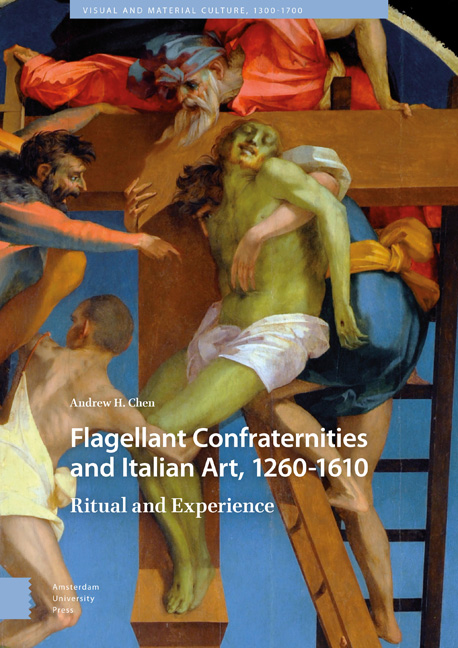Book contents
- Frontmatter
- Deduction
- Contents
- Abbreviations
- List of Illustrations
- Acknowledgements
- Introduction
- Part I Art and Ritual, to 1450
- 1 Flagellation and Its Settings
- 2 Images at Entrances, and Ascesis
- 3 Mass
- 4 Comforting
- 5 Processions
- Part II Transformations
- 6 Changes in Ritual Before Trent
- 7 Changes in imagery before Trent: Sansepolcro and Volterra
- 8 After Trent: Florence and Milan
- Epilogue: Global Flagellation
- Bibliography
- Index of Illuminated Manuscripts (by location)
- Index of Paintings (by location)
- Index of Topics
- Frontmatter
- Deduction
- Contents
- Abbreviations
- List of Illustrations
- Acknowledgements
- Introduction
- Part I Art and Ritual, to 1450
- 1 Flagellation and Its Settings
- 2 Images at Entrances, and Ascesis
- 3 Mass
- 4 Comforting
- 5 Processions
- Part II Transformations
- 6 Changes in Ritual Before Trent
- 7 Changes in imagery before Trent: Sansepolcro and Volterra
- 8 After Trent: Florence and Milan
- Epilogue: Global Flagellation
- Bibliography
- Index of Illuminated Manuscripts (by location)
- Index of Paintings (by location)
- Index of Topics
Summary
Much has been written about the confraternity processional banner, cited in documents as gonfalone, stendardo, palio, bandiera, insegna, or vessillo (vexillum in Latin). The most significant recent publication on this topic is Andreas Dehmer’s Italienische Bruderschaftsbanner des Mittelalters und der Renaissance, a survey of cloth banners published in 2004. Because they were comparatively light, cloth banners could be large, sometimes exceeding two metres in height. Wooden banners, not included in Dehmer's catalogue, were normally half a metre to just over a metre tall. It was common for both kinds to be double-sided.
Banners functioned as both mobile and stationary objects. They could be placed on altars when not in processional use. The miniature from Modena discussed in Chapter 1 shows a banner acting as a temporarily fixed focal point for devotion (Plate 5). Some confraternal laude explicitly instruct audiences to gather around the banner and take the discipline.
When banners went out on procession – hovering at the head of a confraternity, illuminated by candles, presented to the community – special meanings were activated. The floating banner advertised that the confraternity was under the leadership and protection of the saint or saints to which it was dedicated. In a sense the banner stood for that protection. Marian confraternities often had, on their banners, the Virgin of Mercy, an iconography that asserted, by showing the confraternity sub Mariae pallio, that it was in her care. The word used for mantle, pallium/palio, could also refer to banners; confratelli could think of themselves as processing under objects with shielding powers akin to those of the Virgin's mantle. Dehmer reminds us in his book that processions themselves were for defence of the confraternity's spiritual health. Often they were organized in response to plague, and the iconography of some banners reflects this desire to be saved from epidemic.
The iconographies of the fronts and backs of banners can often be seen to follow a pattern: one side shows the dedication of a confraternity, and the other has a Passion image. Banners from Sansepolcro conform to this logic.
- Type
- Chapter
- Information
- Flagellant Confraternities and Italian Art, 1260–1610Ritual and Experience, pp. 141 - 150Publisher: Amsterdam University PressPrint publication year: 2018



